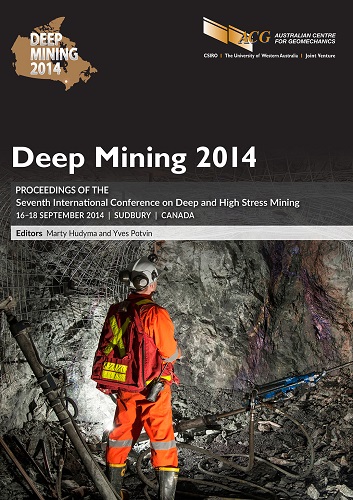Towards continuous bulk production from below 2.5 km

|
Authors: Morrison, D; Parsons, H; Akerman, A |
DOI https://doi.org/10.36487/ACG_rep/1410_01_Morrison
Cite As:
Morrison, D, Parsons, H & Akerman, A 2014, 'Towards continuous bulk production from below 2.5 km', in M Hudyma & Y Potvin (eds), Deep Mining 2014: Proceedings of the Seventh International Conference on Deep and High Stress Mining, Australian Centre for Geomechanics, Perth, pp. 57-63, https://doi.org/10.36487/ACG_rep/1410_01_Morrison
Abstract:
Current underground mining practice consists of a series of discrete tasks and subtasks, rather than a continuous process. These discrete tasks involve a great deal of human intervention including equipment relocation and equipment maintenance and repair. As mining becomes deeper, the intervention of human intelligence will remain essential to the process, and environmental conditions will make physical intervention prohibitively expensive and undesirable. Despite progress in automation and tele-operation, the prospect of a fully man-less operation underground seems as remote as ever. The Centre for Excellence in Mining Innovation (CEMI) believes that the problem lies not with automation, but with the design of the activities that have been automated. Industry has chosen to use automation simply to eliminate people from the activities and has left the equipment, the tasks they perform, and the process in which they are engaged all but unchanged. The CEMI approach is to redesign the individual activities in the production process so they can be managed as a series of simple, linked activities in a semi-continuous production system, made possible with the advent of underground wireless communication systems capable of conveying large amounts of data at low cost. We address the kinds of changes that must be made if we are to approach a much more cost-effective, semi-continuous ore production process with 100% utilisation of the face and maximum productive utilisation of the stope.
References:
Labrecque Technologies Inc. 2014, Paste Fill Simulation, report to the Centre for Excellence in Mining Innovation by P Labrecque and N Runciman, Labrecque Technologies Inc., Sudbury.
Mining Innovation, Research and Rehabilitation Corporation 2014, Cooling Options for ultra-deep Mines in Northern Ontario, report to the Centre for Excellence in Mining Innovation by Dr D Millar, MIRARCO, Sudbury.
© Copyright 2025, Australian Centre for Geomechanics (ACG), The University of Western Australia. All rights reserved.
View copyright/legal information
Please direct any queries or error reports to repository-acg@uwa.edu.au
View copyright/legal information
Please direct any queries or error reports to repository-acg@uwa.edu.au